All about Japanese tattoos

Japan is famous for its rich history and high spiritual values - the inhabitants of the country responsibly observe traditions and customs for many centuries. Tattoos have played a significant role in Japanese culture, in which people have invested a deep meaning for a long time.
Initially, wearable designs marked the social status of the wearers, but nowadays they have become a separate original tattoo style.
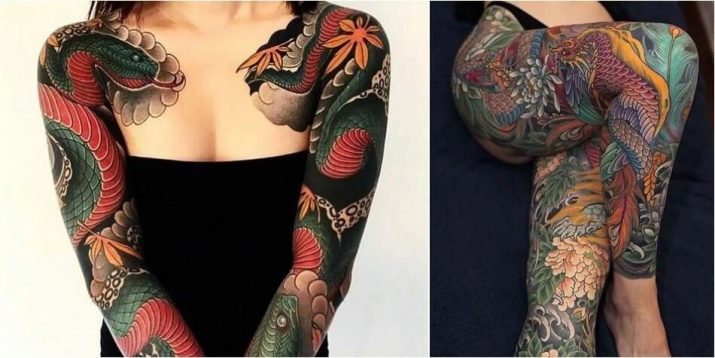
Peculiarities
Japanese tattoos appeared several centuries ago, the variety of images was then very modest and had a certain meaning. The first wearable designs could be found on the skin of two types of people: criminals who must be branded, and representatives of the estates to mark their high status. The tool for applying ink under the skin was an ordinary thorn removed from a plant.
After some time, tattoos, which were applied using ink injection, became more accessible to the people and acquired the name irezumi. The beauty of indelible paintings first attracted geisha, and then priests and lovers. Gradually, tattoos became more and more popular, and the Japanese put more and more new interpretations into them - from the type of activity of the wearer to the number of children in the family. As a result, traditional tattooing has become an integral part of Japanese culture and life.
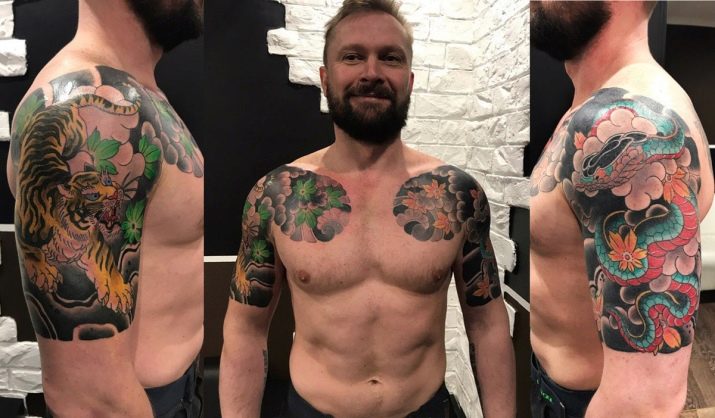
In Japanese body designs, there is a division into main and secondary parts - this feature helps to give the tattoo a clearer, formulated meaning.
Important symbols stand out for their curvy shape, and images of the second order only emphasize the interpretation of the central figure with bright colors.... The presence of major and minor parts helps to capture the main message of the picture, reinforcing the interpretation with additional significant elements.
Japanese-themed tattoos always carry deep meaning and tell others different details about the character or life of their wearer. Each image has its own meaning, subtext and symbolism, which is associated with the life position or fate of the owner. Any drawing, even the simplest one in the form of a flower or a realistic picture of a samurai, has a prominent feature that unites it with the wearer.
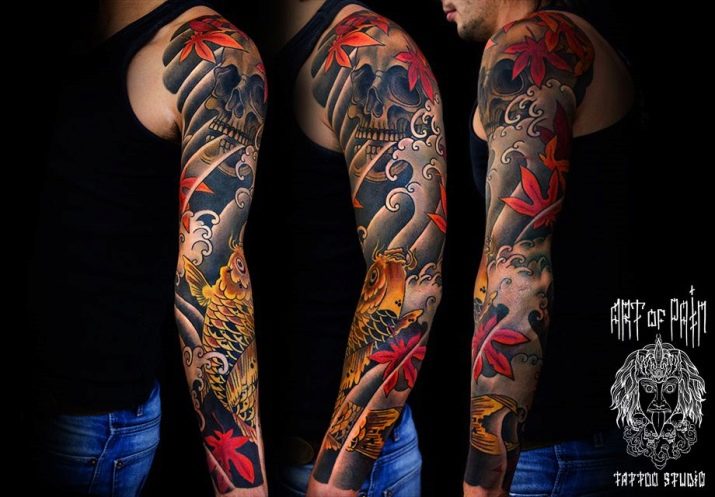
Not only the choice of an image that unites the subject and the owner plays an important role when applying a tattoo - the place on the body is also of great importance. Craftsmen carefully select the location for the picture so as to maximize the dynamism and provide a good overview of the details.
In Japan, it is believed that a person, filling a tattoo, changes his lifestyle and obeys the spiritual influence of the chosen sketch. A depiction that contrasts with the wearer's lifestyle can dramatically change their behavior or enhance the character traits that the indelible illustration symbolizes.
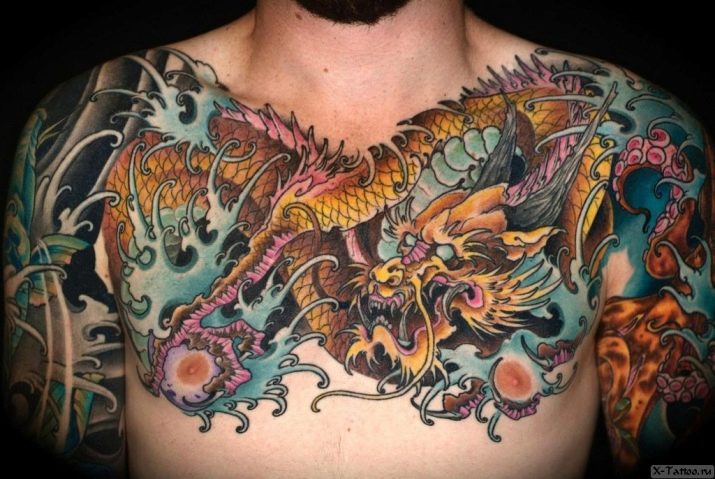
Types of tattoos and sketches
Japan-style tattoos are easy to distinguish from any other styles at first glance, because they are performed in a special, original technique. Each painting carries a deep philosophical implication and individual meaning. Each wearable pattern is unique, because it is always selected so as to match the characteristics of the future owner. However, among Japanese illustrations, there are sketches that are especially popular among tattoo lovers. Let's take a closer look at the most common Japanese wearable designs.
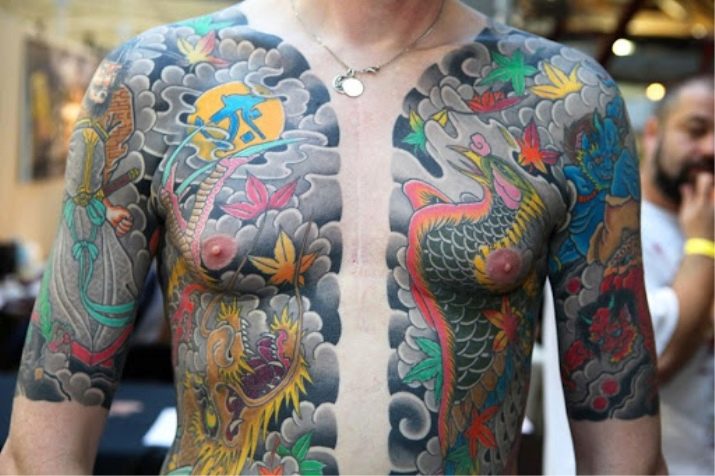
Masks
Tattoos in the style of the Land of the Rising Sun look mysterious and mysterious, and masks are the main representative of this type of sketches. The mask embodies secrecy and duality, protecting the true nature of a person from ill-wishers... Skilled craftsmen create rich color sketches, giving them a pronounced aggressive note through the contrast of shades and facial expressions. Dangerous animals and evil grimaces on such tattoos symbolize firmness of character, strength and readiness to defend themselves.
Japanese mythology contains three main types of masks: demonic, samurai, and Hannya.
- Demon mask. In Japanese mythology, there are a lot of different supernatural creatures, but masks of two demons, Oni and Tengu, are most often used for body drawings. They are an evil demon, a servant of the god of death, outwardly similar to a person, but possessing large fangs and long horns. This creature protects only good people, and brings troubles to the evil.
Demon Tengu can have two different forms: Karasu-Tengu - a humanoid raven, and Yamabushi-Tengu - a creature with a terrible red face and a long nose. In any form, this creature is a protector of nature, he helps kind people and punishes those who harm the forest. The meaning of tattoos with such masks directly tells about their wearer - reveals his position in life and shows his true intentions.
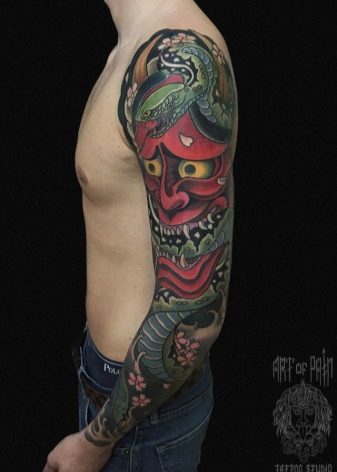
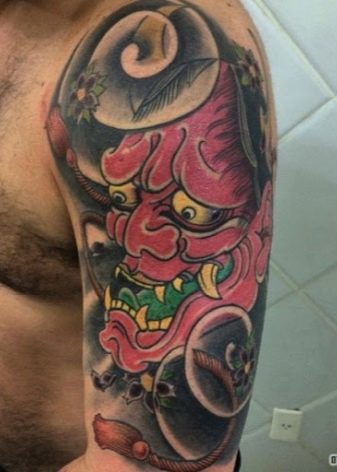
- Samurai mask. Mengu or Meng Yoroi are special combat masks that were used by Japanese samurai to protect their faces from damage and intimidate opponents. In some cases, the armor covering the face was needed to keep the identity of the wearer secret. The peculiarities of mengu give tattoos the meaning of secrecy, devotion, courage, unwillingness to act openly, as well as a willingness to achieve their goals. The person choosing such an illustration is used to hiding their true emotions and is probably more responsible than meets the eye.


- Hannya mask. This accessory also belongs to the demonic mythology of Japan, but deserves special attention.Hannya is a jealous woman's face distorted by hatred. However, the mask looks aggressive only if you look at it directly, and in a slightly tilted position, Hannya changes her emotion to the opposite - a special curl of her eyebrows creates a semblance of an inconsolable sobbing person. The Hannya mask tattoo symbolizes the destructive power of love and gives the wearer the wisdom to overcome their vicious desires. This mask is a powerful amulet for both girls and men.
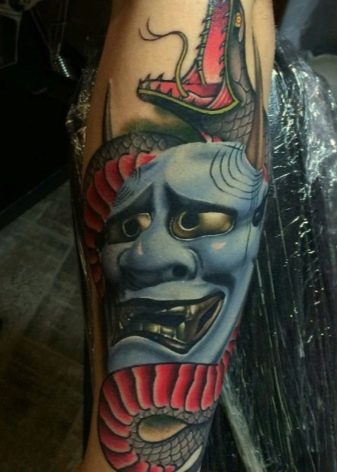
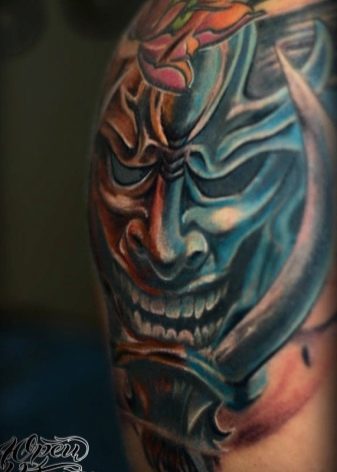
Samurai
Japanese soldiers were faithful servants of their emperors, they selflessly defended them, and paid for their mistakes with their lives. The samurai tattoo has an important religious connotation - in Zen Buddhism, such an image symbolizes the desire to understand the meaning of existence and the willingness to give his life for justice. A sketch with a Japanese warrior means honesty, dedication and obedience to the traditions of his people. It is believed that this body pattern helps the wearer to achieve physical health, strength and stamina, as well as endows with a subtle sense of justice.
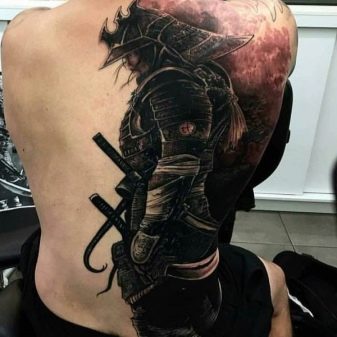

Most often, samurai tattoos are black and white or dark gray - the same as their ancestors depicted them. However, modern craftsmen often create sketches in color, containing a lot of red, blue and yellow shades.... Each of the fundamental colors of the tattoo has a special meaning: red is a symbol of masculinity and determination, blue is a sign of wisdom and peace, yellow is a sign of restraint and deference.
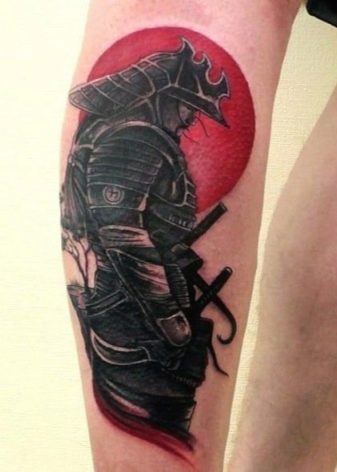
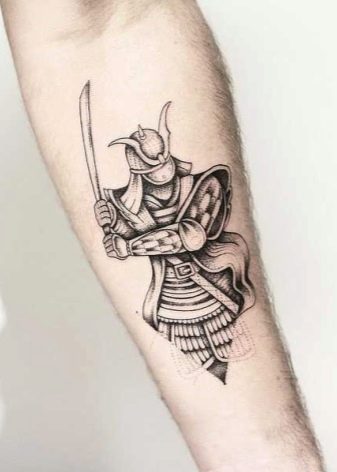
Koi carps
In Japanese culture, these small fish represent masculine strength, endurance and family happiness. One brocade carp brings good luck to its owner, and the larger the sketch, the stronger its influence. A pair of fish circling in a dance denote a harmonious relationship between a man and a woman, as well as the well-known Yin-Yang sign. High values are given to Koi carps for a reason - at one time even samurai were equal to their courage, because a modest fish will never flinch, even under pain of death from a cook's carving knife.
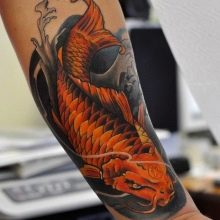
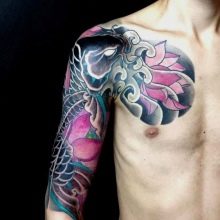

Of particular importance is the water in which it floats brocade carp... A tattoo with a turbulent river flow means the wearer's readiness to overcome difficulties. Calm water, on which waves appear only from the movement of the carp, symbolizes the triumph of achieving the goal.
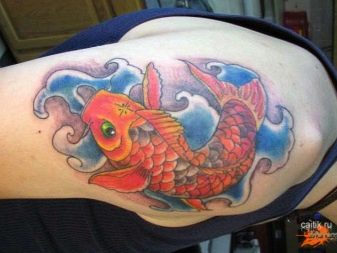
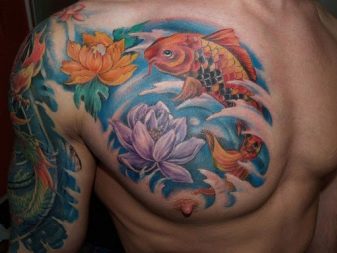
Tigers
In the mythology of the Land of the Rising Sun, the tiger is a strong, hardy and fast predator. The power of the beast helped him become the strongest among animals and allowed him to conquer power. The sketch with the predator has conflicting interpretations, which are reflected in the character of the wearer, because the animal can be both noble and magnanimous, and cruel. The Japanese style tiger tattoo is suitable for people in high office or in power.
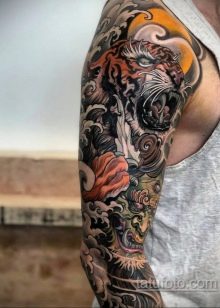
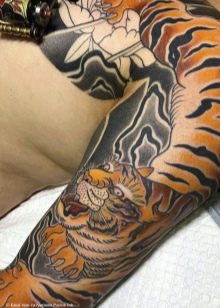
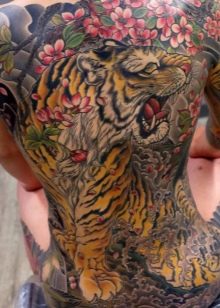
The main meaning of the tattoo can be conveyed through the pose of a tiger and the emotions reflected on his face.... A beast stretching or relaxing in a relaxed manner indicates that its owner is a wise, strong and balanced person who must be respected.
An aggressive tiger with a bared mouth suggests that its host has overcome many difficulties and is ready to fight to achieve its goals at any cost.


Dragons
Dragons are mystical creatures described in the mythology of eastern countries... These magical beasts symbolize strength, justice, mystery and the ability to overcome the constraints of real life. A dragon tattoo is intended to highlight the determination, dedication and beauty of its wearer.
The mythical dragon is an intelligent creature with all the knowledge of the world, therefore it is a sign of justice and wisdom.
A dragon tattoo helps its wearer overcome difficulties and easily acquire new skills.
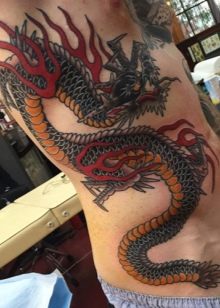

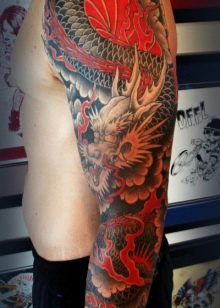
Buddha
Buddha is an enlightened person who professes Buddhism and the founder of the teachings of the philosophy of being... However, he is not a deity - in ancient times he was an ordinary person who retained faith in karma and rebirth. The Buddha tattoo symbolizes the purity of the soul and the willingness to give up material values in favor of spiritual enlightenment.
A sketch with such a symbol is chosen by people seeking to comprehend the highest meaning of existence. The drawing helps the wearer reach a state in which no personal desires and attachments will burden the wearer's head. This state is called nirvana - a feeling of pleasure from life itself.

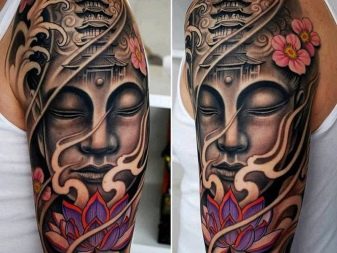
Flowers
In Japan, one of the meanings of flower tattoos is the cyclical nature of life. The interpretation is that a person is born and dies in the same way as a flower blooms in spring and dries up in autumn. Flowers are predominantly female sketches, but in combination with other symbols can be applied to male skin. Depending on the type of plant, the tattoo has a different meaning.
-
Chrysanthemum... In Japanese culture, chrysanthemum is equated with the faces of emperors for its beauty. The tattoo of this flower attracts well-being to its wearer. The Japanese associate blossoming chrysanthemum petals with the sun's rays, which give happiness, fun and long life.


- Sakura... Flowers on Japanese cherry blossom bloom in early spring, dazzling with their beauty, and just wither a day later. Sakura tattoos symbolize maiden beauty and youth - the same fragile, beautiful and fleeting.

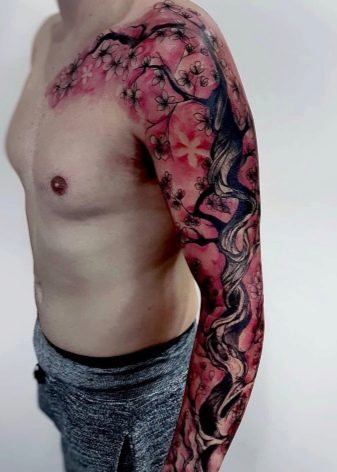
- Lotus... A beautiful water flower that is a symbol of development and harmony. A lotus tattoo means benevolence, cheerfulness and emotionality of its owner.
The lotus, made in the style of minimalism, symbolizes wisdom and enlightenment, because this technique is close in meaning to the abandonment of earthly desires in favor of spiritual values.

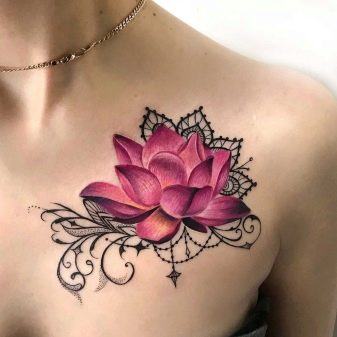
Snakes
The snake is an ambiguous symbol - it can simultaneously talk about the calmness and patience of the owner, but at the same time about his deceit and hypocrisy. For this reason, snakes are rarely depicted as the central figure of a tattoo or supplemented with positive symbols that clearly indicate the interpretation of the sketch.
A suitable addition to the image of the snake is the background with chrysanthemums - such a duet takes on a very deep connotation.
The flower personifies well-being and happiness, and the snake acts as the protector of the family hearth, taking away adversity, illness and quarrels from the house.
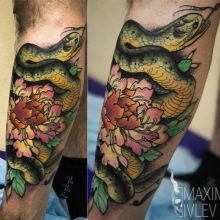
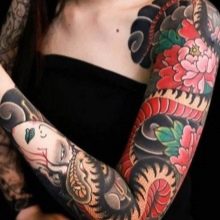
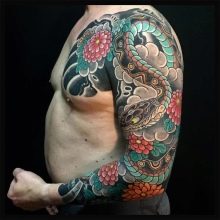
Other
The assortment of Japanese-style tattoos amazes the imagination with a variety of ideas - among them there are simple drawings with obvious meaning and complex plot pictures with deep philosophical overtones. We suggest you familiarize yourself with some interesting ideas for Japanese wearable illustrations.
-
Toad... In the culture of Japan, the frog is a supernatural creature with "toad magic". Combined with coins, a toad tattoo brings success and wealth to the wearer.

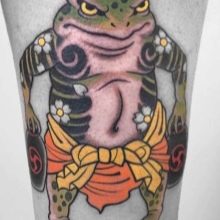
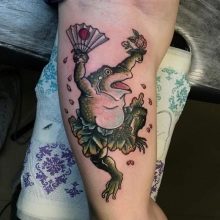
- Baku... A mythical monster, consisting of body parts of different animals - an elephant's trunk, rhino eyes and tiger paws. Despite its frightening appearance, the creature is a defender of people from nightmares. The Japanese believe that Baku is devoured by a bad dream: if you shout the phrase “Baku, eat” three times, then the nightmare will not come true. A tattoo with a mythical beast protects the wearer from evil thoughts, diseases and evil.
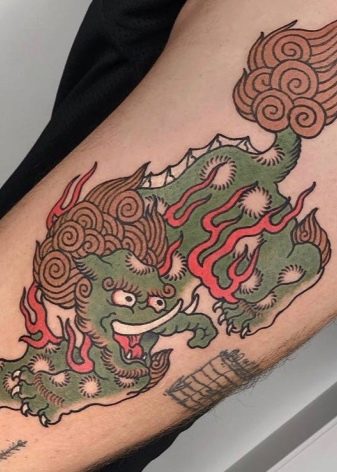
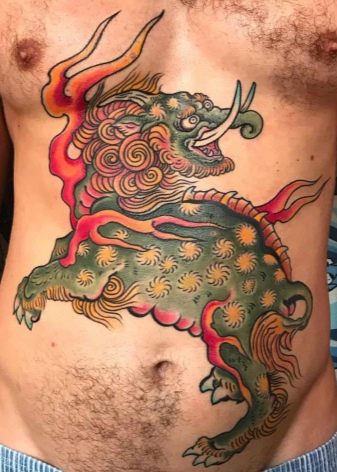
- Maneki-neko. A popular Japanese character whose name translates as "alluring cat". According to one of the legends, maneki-neko became famous due to the fact that a cat saved a person from death in a thunderstorm, beckoning him with a paw to a dilapidated temple. In gratitude, the man donated funds for the repair of the temple, and from that moment the cat with an alluring paw has been a revered religious symbol. A tattoo of an animal with a raised paw attracts material well-being and success in career growth to its owner.
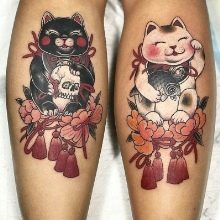

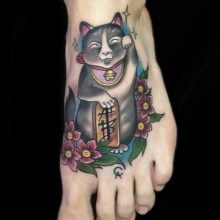
Accommodation options
In the Land of the Rising Sun, it is believed that the location of the tattoo on the body is very important for its meaning. The Japanese consider the following arrangement of tattoos to be successful:
-
on the shoulder a suitable place for sketches of animals and samurai, as it is clearly visible;
-
forearm - an ideal area on the hand, suitable for the location of a dragon or a samurai mask, which will help show your stamina and courage;
-
on the hands a great place for a minimalist tattoo with Koi carp, tiger or dragon face to declare serious intentions;
-
on the neck it is best to place chrysanthemum, peony or lotus to emphasize grace;
-
on the chest usually have tattoos with a deep philosophical or romantic context, because the heart is nearby - the main rival of the brain in importance;
-
on the back most often, large tattoos are depicted, covering an area from the shoulders to the tailbone, so that the depicted talismans bring maximum benefit, because their strength directly depends on size;
-
on leg it is advised to depict tattoos that attract strength and health to the wearer - they will help the tattoo wearer maintain physical abilities until old age.
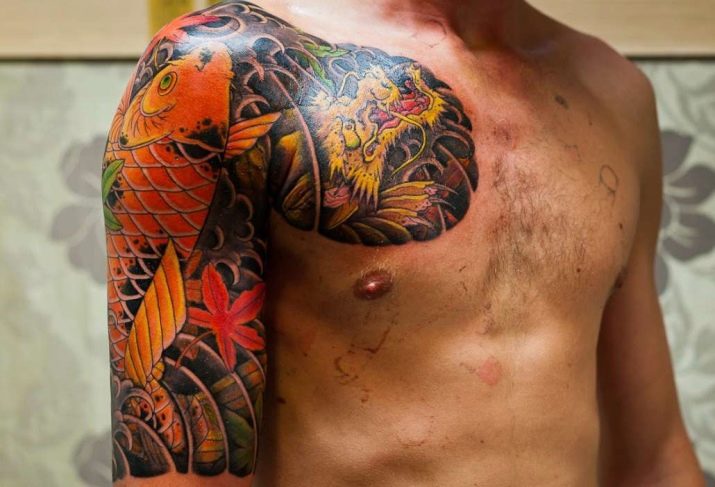
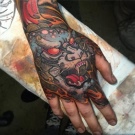
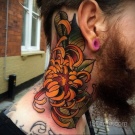
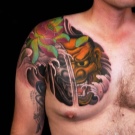

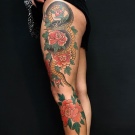
Nuances of application
When choosing a Japanese-style tattoo, remember that these are often large illustrations with a lot of small details. Before choosing the final sketch, you need to evaluate it according to several criteria:
-
purpose of drawing - the meaning of the selected picture must correspond to what you want to change or emphasize in your character;
-
technique of execution and coloring - black and white and color tattoos differ greatly in meaning and complexity of application, so it is necessary to think over the color scheme in advance;
-
complementary elements - if the drawing seems incomplete to you, empty spaces can be filled with flowers or other interesting elements that correctly emphasize the interpretation of the sketch.









